BCO127 Applied Management Statistics Assignment: Problem Solving
VerifiedAdded on 2022/09/13
|10
|1336
|13
Homework Assignment
AI Summary
This document presents a comprehensive solution to an Applied Management Statistics assignment, addressing various statistical problems. The assignment covers key concepts such as population and sampling techniques, confidence intervals, hypothesis testing, and regression analysis. The solution includes detailed explanations for each part of the questions, including the calculation of confidence intervals, conducting t-tests, interpreting regression models, and applying sampling methods. The assignment also provides practical examples related to e-commerce delivery times, analysis of annual income based on work experience, and assessing college students' opinions on transportation systems. The document offers a complete analysis of the given scenarios, making it a valuable resource for students studying applied management statistics. Additionally, this resource is available on Desklib, a platform that offers AI-based study tools for students.
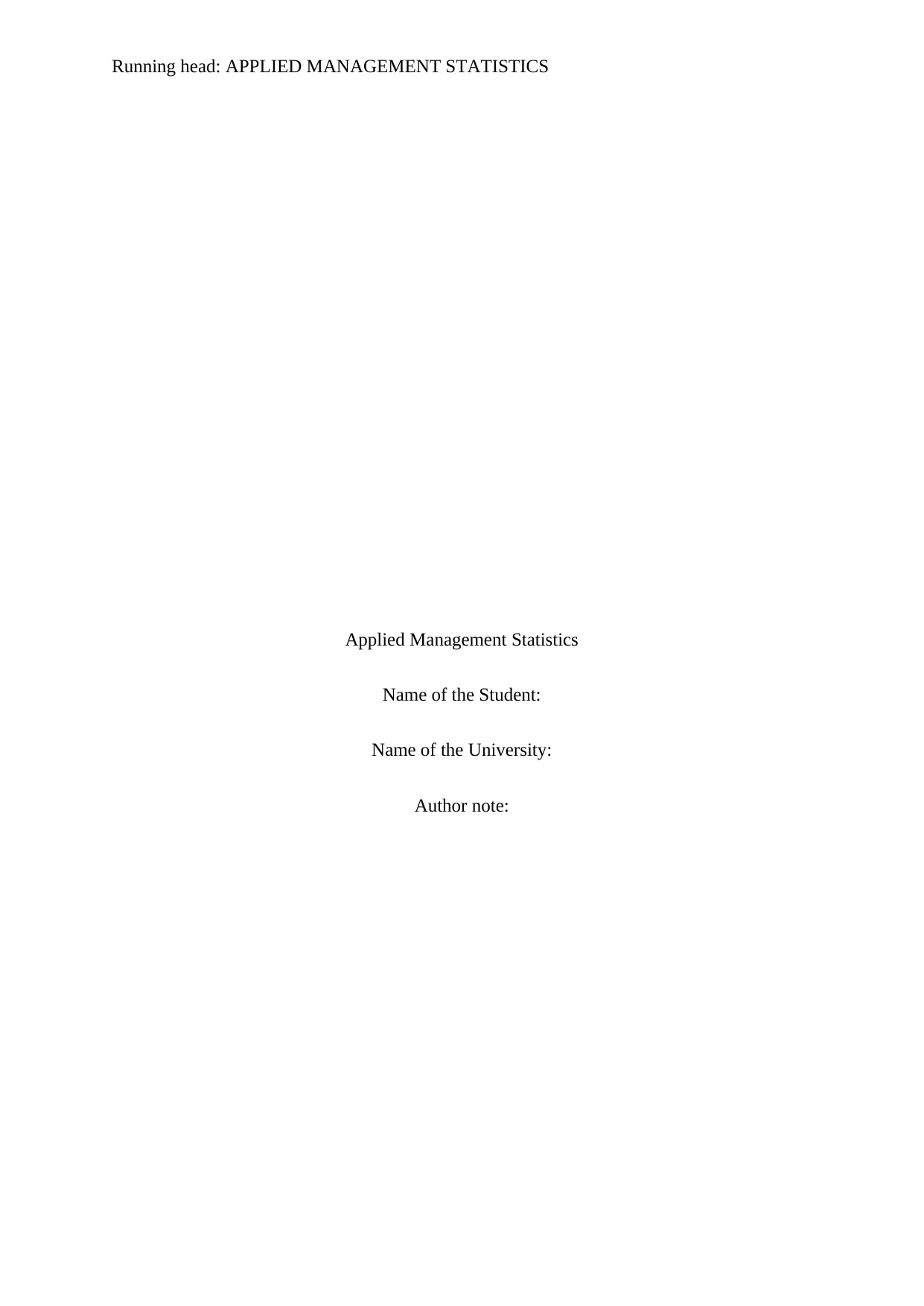
Running head: APPLIED MANAGEMENT STATISTICS
Applied Management Statistics
Name of the Student:
Name of the University:
Author note:
Applied Management Statistics
Name of the Student:
Name of the University:
Author note:
Paraphrase This Document
Need a fresh take? Get an instant paraphrase of this document with our AI Paraphraser
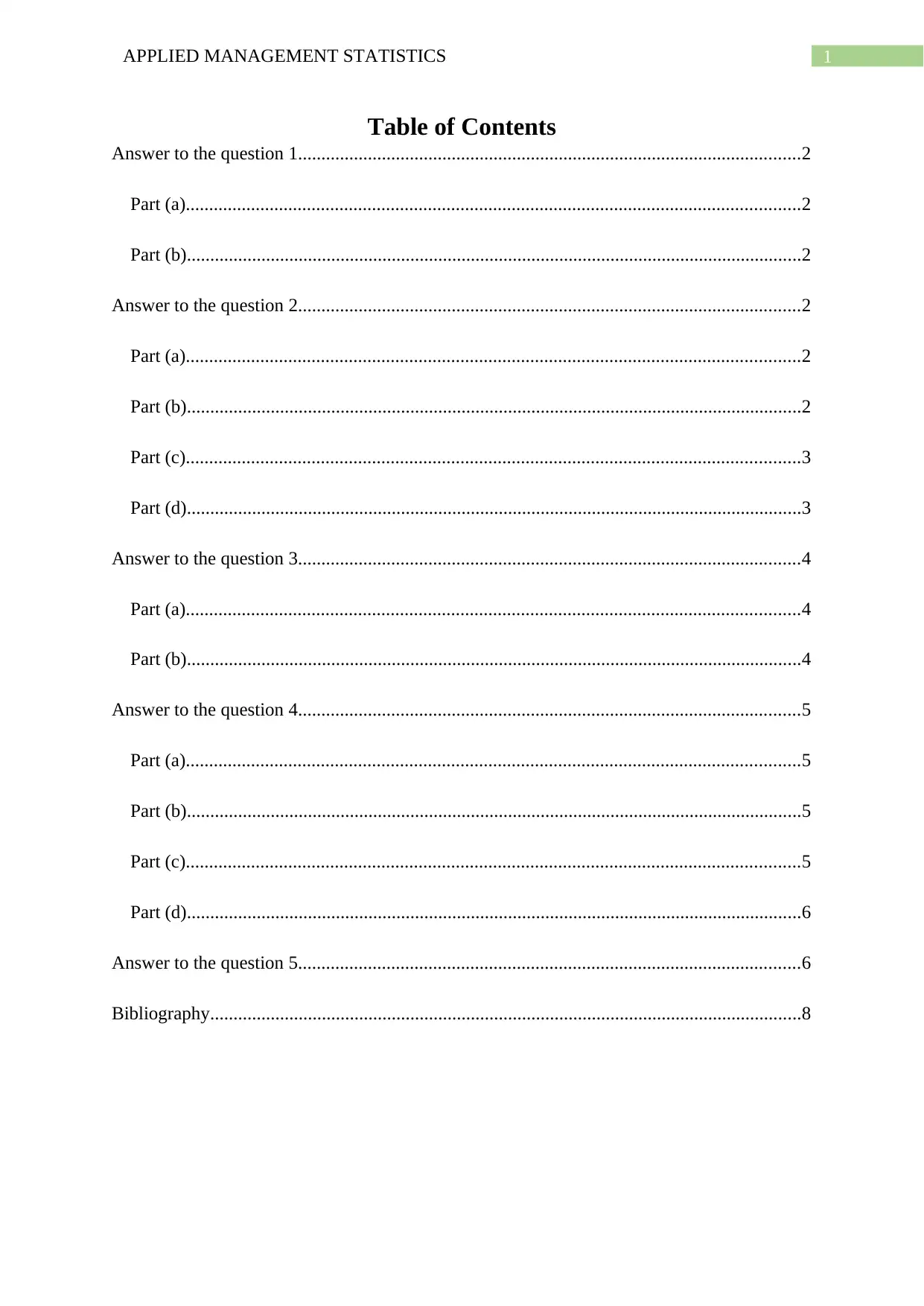
1APPLIED MANAGEMENT STATISTICS
Table of Contents
Answer to the question 1............................................................................................................2
Part (a)....................................................................................................................................2
Part (b)....................................................................................................................................2
Answer to the question 2............................................................................................................2
Part (a)....................................................................................................................................2
Part (b)....................................................................................................................................2
Part (c)....................................................................................................................................3
Part (d)....................................................................................................................................3
Answer to the question 3............................................................................................................4
Part (a)....................................................................................................................................4
Part (b)....................................................................................................................................4
Answer to the question 4............................................................................................................5
Part (a)....................................................................................................................................5
Part (b)....................................................................................................................................5
Part (c)....................................................................................................................................5
Part (d)....................................................................................................................................6
Answer to the question 5............................................................................................................6
Bibliography...............................................................................................................................8
Table of Contents
Answer to the question 1............................................................................................................2
Part (a)....................................................................................................................................2
Part (b)....................................................................................................................................2
Answer to the question 2............................................................................................................2
Part (a)....................................................................................................................................2
Part (b)....................................................................................................................................2
Part (c)....................................................................................................................................3
Part (d)....................................................................................................................................3
Answer to the question 3............................................................................................................4
Part (a)....................................................................................................................................4
Part (b)....................................................................................................................................4
Answer to the question 4............................................................................................................5
Part (a)....................................................................................................................................5
Part (b)....................................................................................................................................5
Part (c)....................................................................................................................................5
Part (d)....................................................................................................................................6
Answer to the question 5............................................................................................................6
Bibliography...............................................................................................................................8
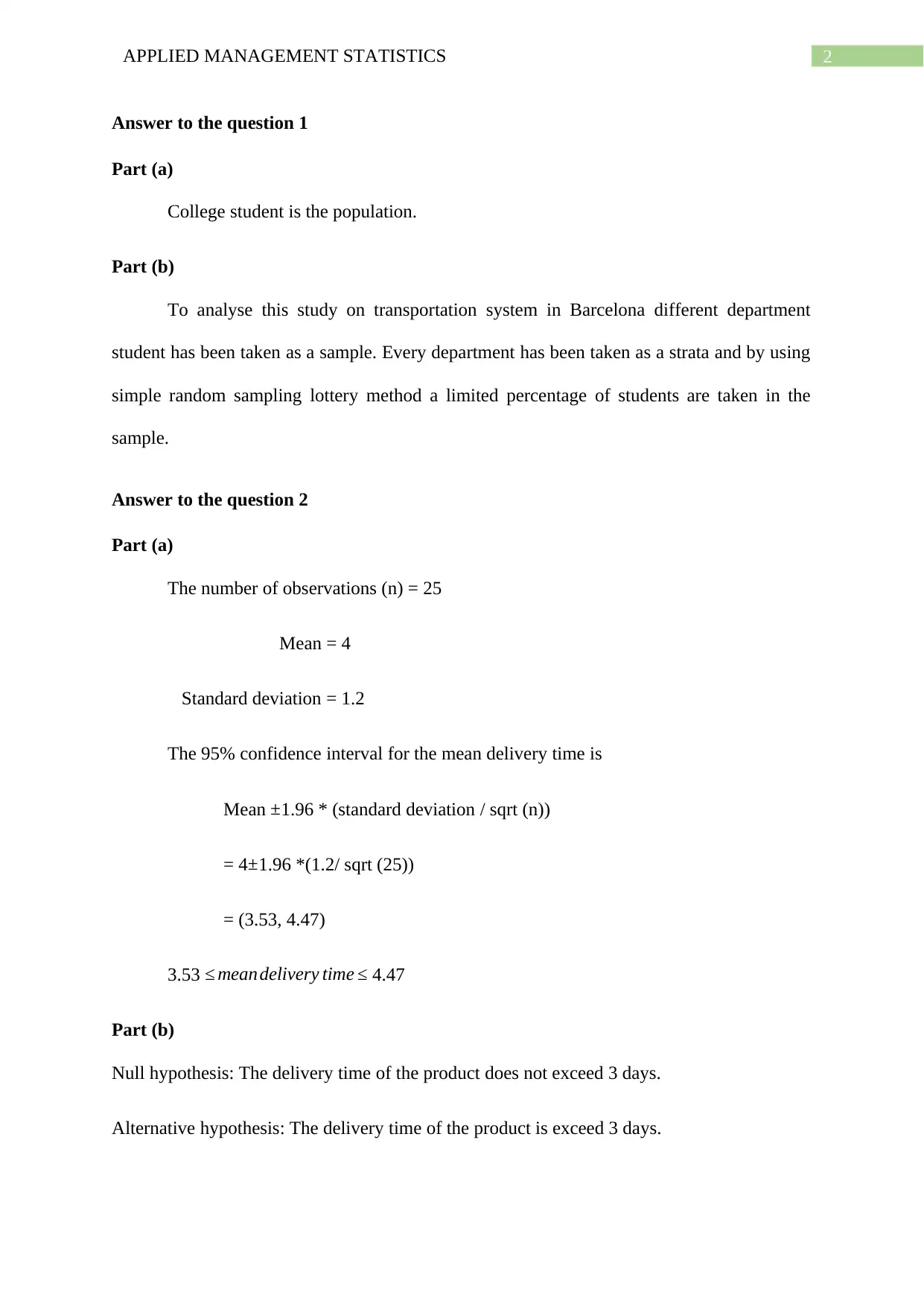
2APPLIED MANAGEMENT STATISTICS
Answer to the question 1
Part (a)
College student is the population.
Part (b)
To analyse this study on transportation system in Barcelona different department
student has been taken as a sample. Every department has been taken as a strata and by using
simple random sampling lottery method a limited percentage of students are taken in the
sample.
Answer to the question 2
Part (a)
The number of observations (n) = 25
Mean = 4
Standard deviation = 1.2
The 95% confidence interval for the mean delivery time is
Mean ±1.96 * (standard deviation / sqrt (n))
= 4±1.96 *(1.2/ sqrt (25))
= (3.53, 4.47)
3.53 ≤ meandelivery time ≤ 4.47
Part (b)
Null hypothesis: The delivery time of the product does not exceed 3 days.
Alternative hypothesis: The delivery time of the product is exceed 3 days.
Answer to the question 1
Part (a)
College student is the population.
Part (b)
To analyse this study on transportation system in Barcelona different department
student has been taken as a sample. Every department has been taken as a strata and by using
simple random sampling lottery method a limited percentage of students are taken in the
sample.
Answer to the question 2
Part (a)
The number of observations (n) = 25
Mean = 4
Standard deviation = 1.2
The 95% confidence interval for the mean delivery time is
Mean ±1.96 * (standard deviation / sqrt (n))
= 4±1.96 *(1.2/ sqrt (25))
= (3.53, 4.47)
3.53 ≤ meandelivery time ≤ 4.47
Part (b)
Null hypothesis: The delivery time of the product does not exceed 3 days.
Alternative hypothesis: The delivery time of the product is exceed 3 days.
⊘ This is a preview!⊘
Do you want full access?
Subscribe today to unlock all pages.

Trusted by 1+ million students worldwide
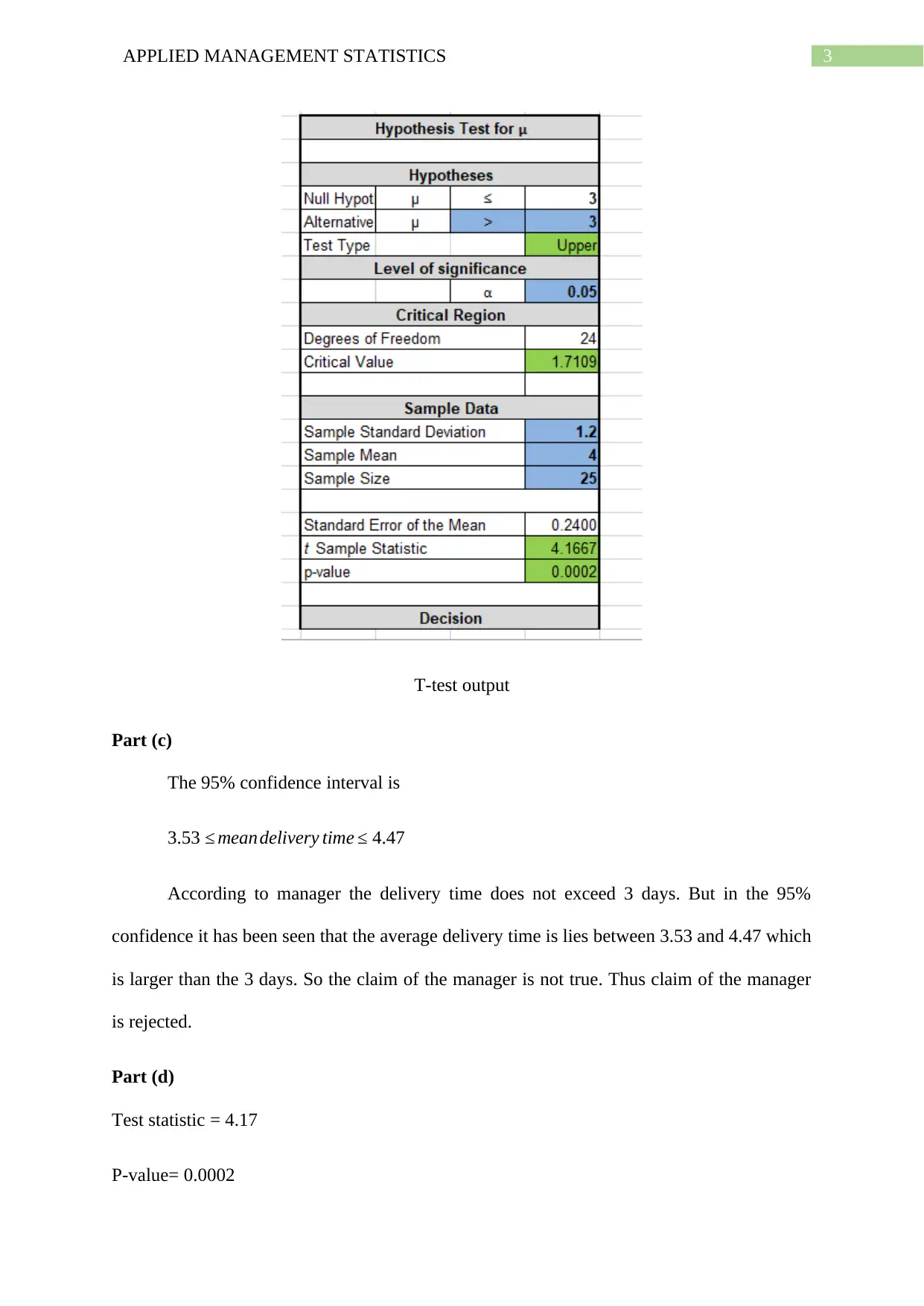
3APPLIED MANAGEMENT STATISTICS
T-test output
Part (c)
The 95% confidence interval is
3.53 ≤ meandelivery time ≤ 4.47
According to manager the delivery time does not exceed 3 days. But in the 95%
confidence it has been seen that the average delivery time is lies between 3.53 and 4.47 which
is larger than the 3 days. So the claim of the manager is not true. Thus claim of the manager
is rejected.
Part (d)
Test statistic = 4.17
P-value= 0.0002
T-test output
Part (c)
The 95% confidence interval is
3.53 ≤ meandelivery time ≤ 4.47
According to manager the delivery time does not exceed 3 days. But in the 95%
confidence it has been seen that the average delivery time is lies between 3.53 and 4.47 which
is larger than the 3 days. So the claim of the manager is not true. Thus claim of the manager
is rejected.
Part (d)
Test statistic = 4.17
P-value= 0.0002
Paraphrase This Document
Need a fresh take? Get an instant paraphrase of this document with our AI Paraphraser
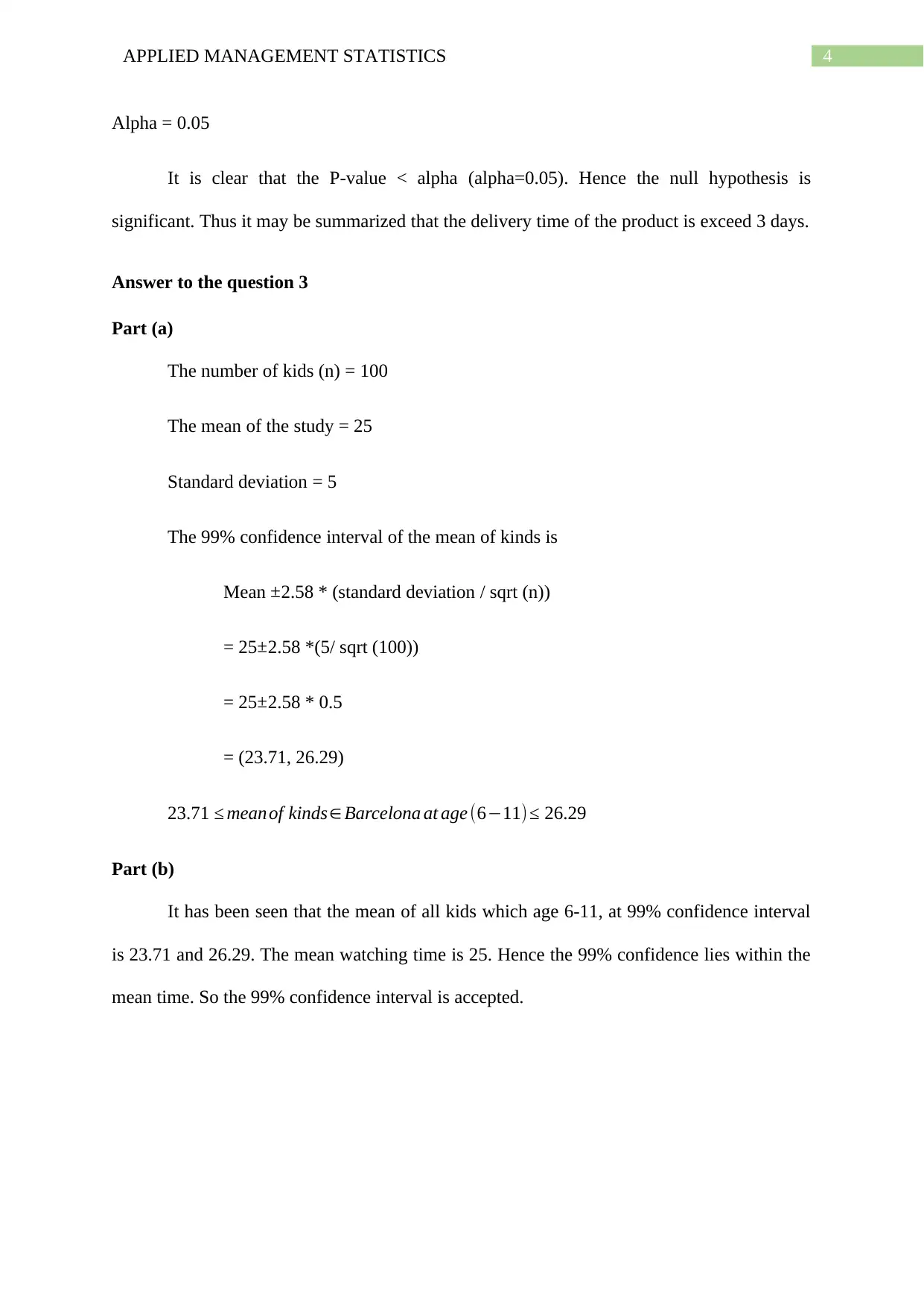
4APPLIED MANAGEMENT STATISTICS
Alpha = 0.05
It is clear that the P-value < alpha (alpha=0.05). Hence the null hypothesis is
significant. Thus it may be summarized that the delivery time of the product is exceed 3 days.
Answer to the question 3
Part (a)
The number of kids (n) = 100
The mean of the study = 25
Standard deviation = 5
The 99% confidence interval of the mean of kinds is
Mean ±2.58 * (standard deviation / sqrt (n))
= 25±2.58 *(5/ sqrt (100))
= 25±2.58 * 0.5
= (23.71, 26.29)
23.71 ≤ meanof kinds∈ Barcelona at age (6−11)≤ 26.29
Part (b)
It has been seen that the mean of all kids which age 6-11, at 99% confidence interval
is 23.71 and 26.29. The mean watching time is 25. Hence the 99% confidence lies within the
mean time. So the 99% confidence interval is accepted.
Alpha = 0.05
It is clear that the P-value < alpha (alpha=0.05). Hence the null hypothesis is
significant. Thus it may be summarized that the delivery time of the product is exceed 3 days.
Answer to the question 3
Part (a)
The number of kids (n) = 100
The mean of the study = 25
Standard deviation = 5
The 99% confidence interval of the mean of kinds is
Mean ±2.58 * (standard deviation / sqrt (n))
= 25±2.58 *(5/ sqrt (100))
= 25±2.58 * 0.5
= (23.71, 26.29)
23.71 ≤ meanof kinds∈ Barcelona at age (6−11)≤ 26.29
Part (b)
It has been seen that the mean of all kids which age 6-11, at 99% confidence interval
is 23.71 and 26.29. The mean watching time is 25. Hence the 99% confidence lies within the
mean time. So the 99% confidence interval is accepted.
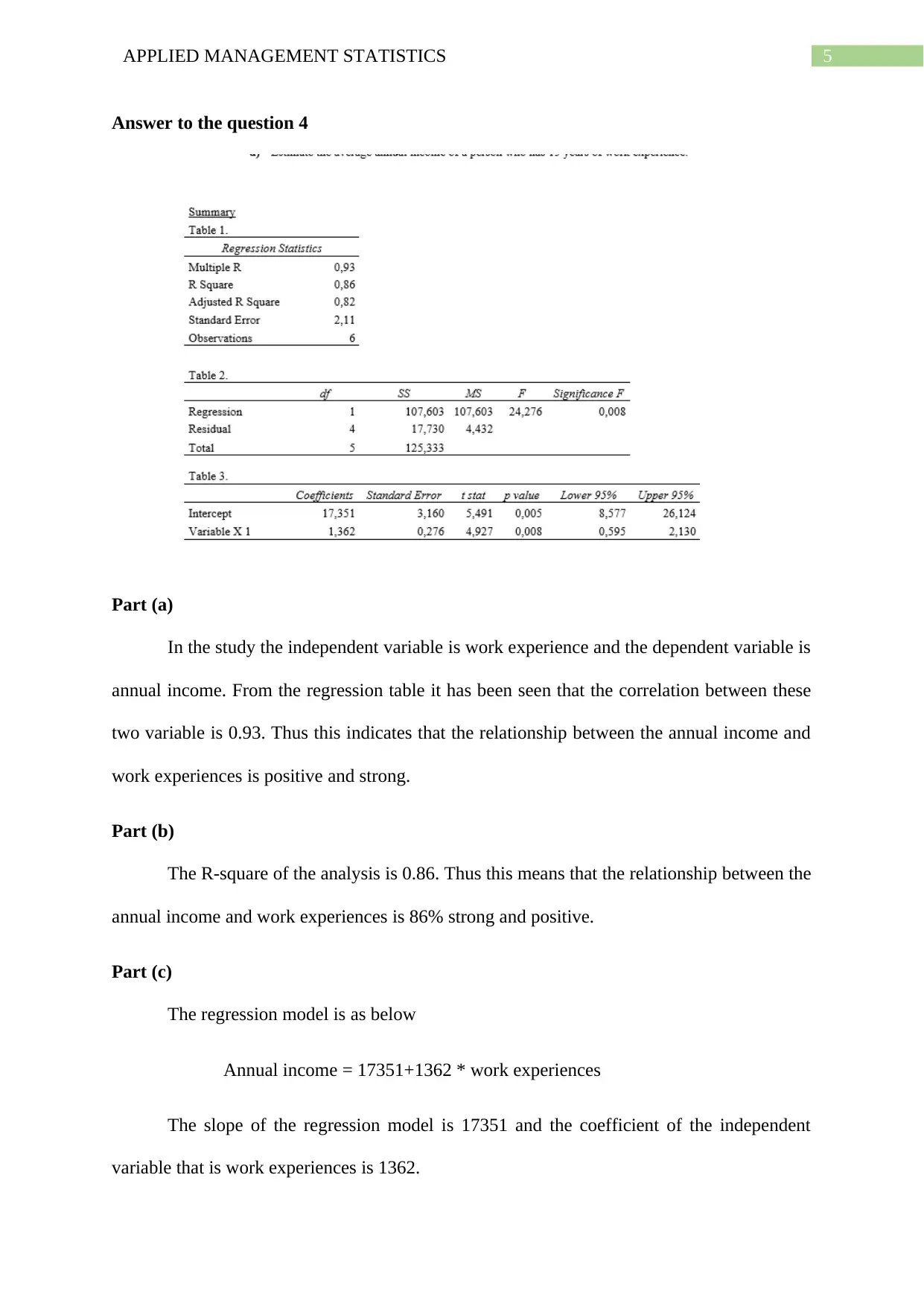
5APPLIED MANAGEMENT STATISTICS
Answer to the question 4
Part (a)
In the study the independent variable is work experience and the dependent variable is
annual income. From the regression table it has been seen that the correlation between these
two variable is 0.93. Thus this indicates that the relationship between the annual income and
work experiences is positive and strong.
Part (b)
The R-square of the analysis is 0.86. Thus this means that the relationship between the
annual income and work experiences is 86% strong and positive.
Part (c)
The regression model is as below
Annual income = 17351+1362 * work experiences
The slope of the regression model is 17351 and the coefficient of the independent
variable that is work experiences is 1362.
Answer to the question 4
Part (a)
In the study the independent variable is work experience and the dependent variable is
annual income. From the regression table it has been seen that the correlation between these
two variable is 0.93. Thus this indicates that the relationship between the annual income and
work experiences is positive and strong.
Part (b)
The R-square of the analysis is 0.86. Thus this means that the relationship between the
annual income and work experiences is 86% strong and positive.
Part (c)
The regression model is as below
Annual income = 17351+1362 * work experiences
The slope of the regression model is 17351 and the coefficient of the independent
variable that is work experiences is 1362.
⊘ This is a preview!⊘
Do you want full access?
Subscribe today to unlock all pages.

Trusted by 1+ million students worldwide
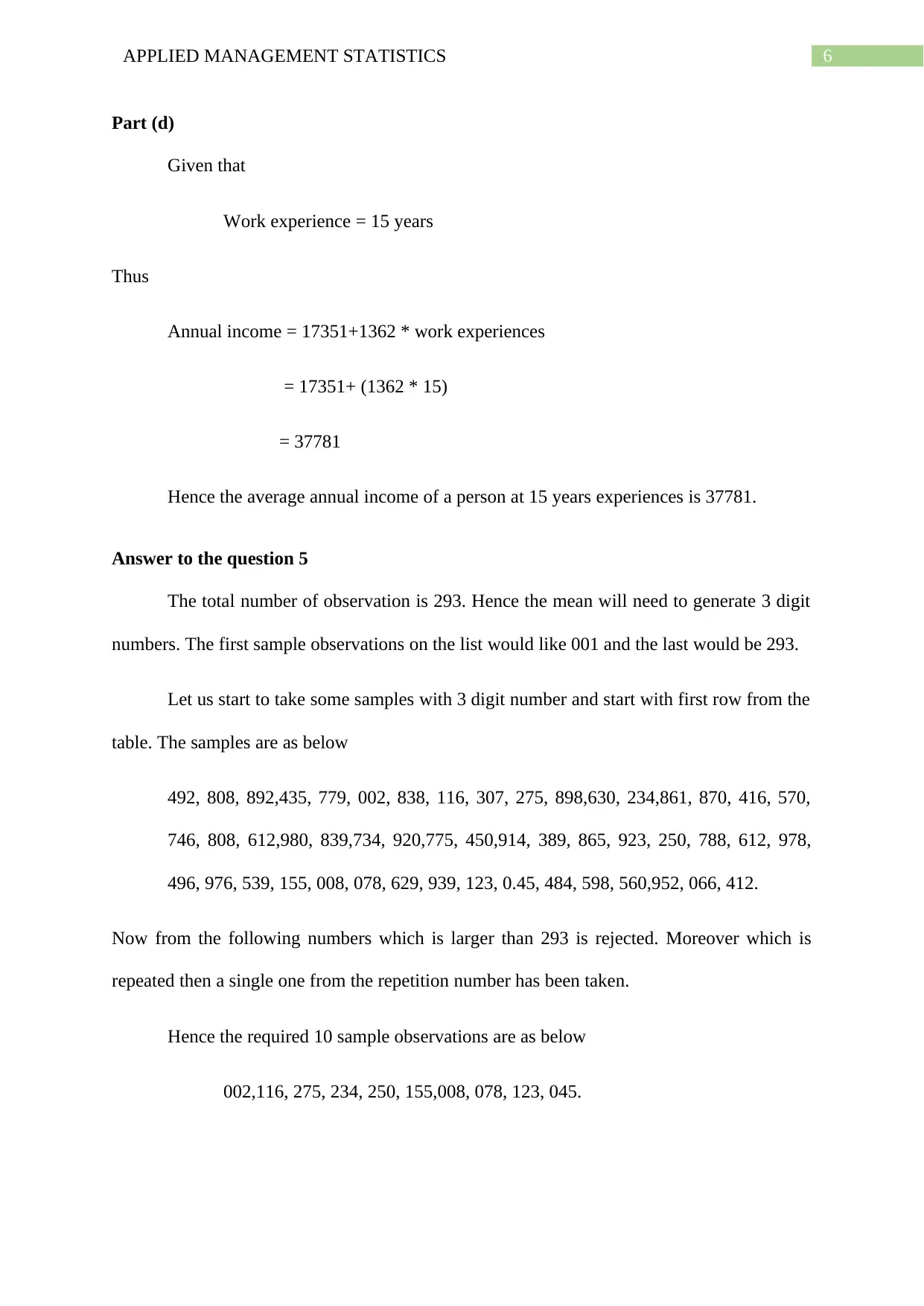
6APPLIED MANAGEMENT STATISTICS
Part (d)
Given that
Work experience = 15 years
Thus
Annual income = 17351+1362 * work experiences
= 17351+ (1362 * 15)
= 37781
Hence the average annual income of a person at 15 years experiences is 37781.
Answer to the question 5
The total number of observation is 293. Hence the mean will need to generate 3 digit
numbers. The first sample observations on the list would like 001 and the last would be 293.
Let us start to take some samples with 3 digit number and start with first row from the
table. The samples are as below
492, 808, 892,435, 779, 002, 838, 116, 307, 275, 898,630, 234,861, 870, 416, 570,
746, 808, 612,980, 839,734, 920,775, 450,914, 389, 865, 923, 250, 788, 612, 978,
496, 976, 539, 155, 008, 078, 629, 939, 123, 0.45, 484, 598, 560,952, 066, 412.
Now from the following numbers which is larger than 293 is rejected. Moreover which is
repeated then a single one from the repetition number has been taken.
Hence the required 10 sample observations are as below
002,116, 275, 234, 250, 155,008, 078, 123, 045.
Part (d)
Given that
Work experience = 15 years
Thus
Annual income = 17351+1362 * work experiences
= 17351+ (1362 * 15)
= 37781
Hence the average annual income of a person at 15 years experiences is 37781.
Answer to the question 5
The total number of observation is 293. Hence the mean will need to generate 3 digit
numbers. The first sample observations on the list would like 001 and the last would be 293.
Let us start to take some samples with 3 digit number and start with first row from the
table. The samples are as below
492, 808, 892,435, 779, 002, 838, 116, 307, 275, 898,630, 234,861, 870, 416, 570,
746, 808, 612,980, 839,734, 920,775, 450,914, 389, 865, 923, 250, 788, 612, 978,
496, 976, 539, 155, 008, 078, 629, 939, 123, 0.45, 484, 598, 560,952, 066, 412.
Now from the following numbers which is larger than 293 is rejected. Moreover which is
repeated then a single one from the repetition number has been taken.
Hence the required 10 sample observations are as below
002,116, 275, 234, 250, 155,008, 078, 123, 045.
Paraphrase This Document
Need a fresh take? Get an instant paraphrase of this document with our AI Paraphraser
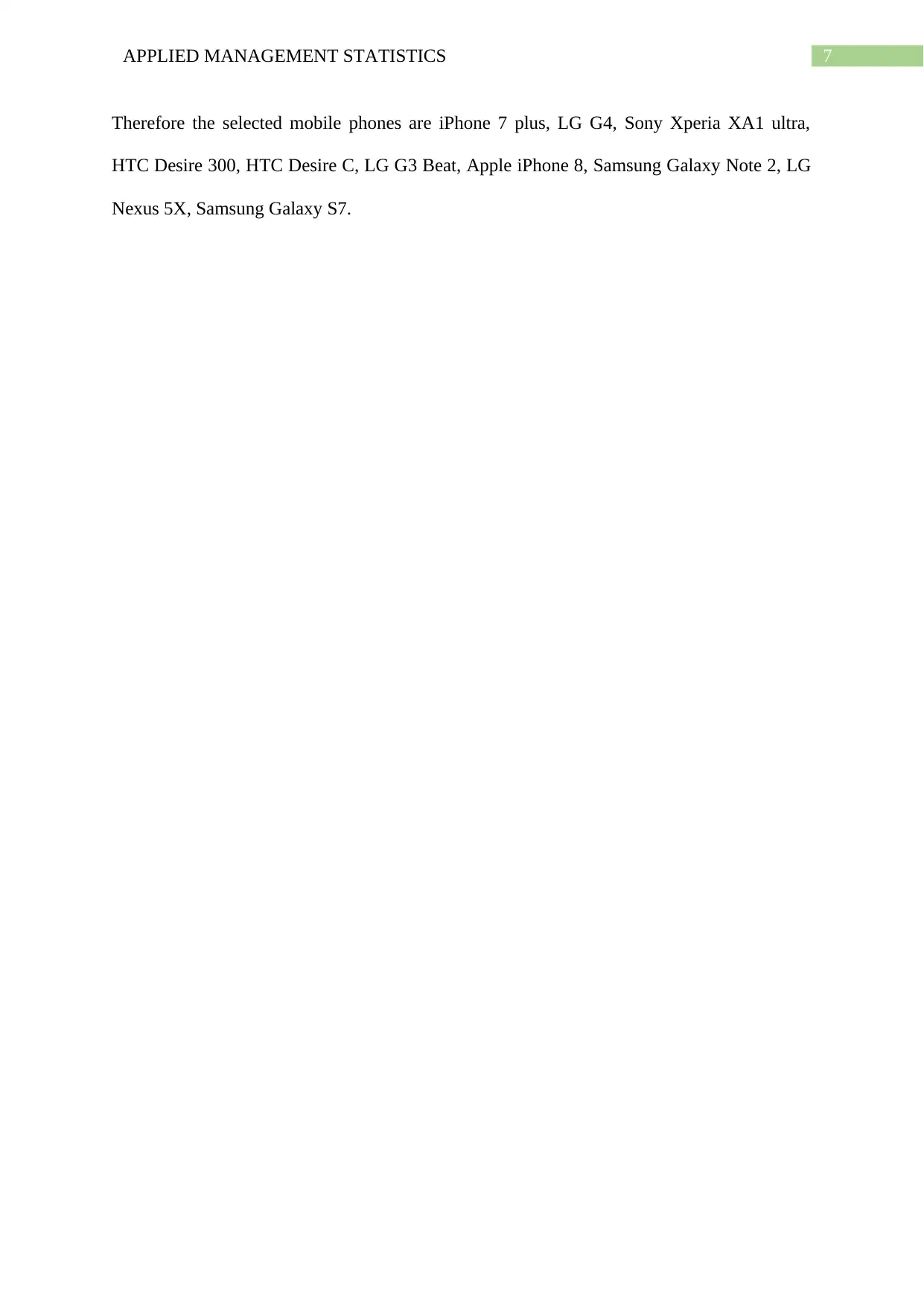
7APPLIED MANAGEMENT STATISTICS
Therefore the selected mobile phones are iPhone 7 plus, LG G4, Sony Xperia XA1 ultra,
HTC Desire 300, HTC Desire C, LG G3 Beat, Apple iPhone 8, Samsung Galaxy Note 2, LG
Nexus 5X, Samsung Galaxy S7.
Therefore the selected mobile phones are iPhone 7 plus, LG G4, Sony Xperia XA1 ultra,
HTC Desire 300, HTC Desire C, LG G3 Beat, Apple iPhone 8, Samsung Galaxy Note 2, LG
Nexus 5X, Samsung Galaxy S7.

8APPLIED MANAGEMENT STATISTICS
Bibliography
De Winter, J.C., 2013. Using the Student's t-test with extremely small sample sizes. Practical
Assessment, Research, and Evaluation, 18(1), p.10.
Giometto, A., Formentin, M., Rinaldo, A., Cohen, J.E. and Maritan, A., 2015. Sample and
population exponents of generalized Taylor’s law. Proceedings of the National Academy of
Sciences, 112(25), pp.7755-7760.
Kruschke, J.K., 2013. Bayesian estimation supersedes the t test. Journal of Experimental
Psychology: General, 142(2), p.573.
Lee, D.K., 2016. Alternatives to P value: confidence interval and effect size. Korean journal
of anesthesiology, 69(6), p.555.
Morey, R.D., Hoekstra, R., Rouder, J.N., Lee, M.D. and Wagenmakers, E.J., 2016. The
fallacy of placing confidence in confidence intervals. Psychonomic bulletin & review, 23(1),
pp.103-123.
Pataky, T.C., Vanrenterghem, J. and Robinson, M.A., 2015. Zero-vs. one-dimensional,
parametric vs. non-parametric, and confidence interval vs. hypothesis testing procedures in
one-dimensional biomechanical trajectory analysis. Journal of biomechanics, 48(7), pp.1277-
1285.
Pencina, M.J., Navar-Boggan, A.M., D'Agostino Sr, R.B., Williams, K., Neely, B.,
Sniderman, A.D. and Peterson, E.D., 2014. Application of new cholesterol guidelines to a
population-based sample. N Engl J Med, 370, pp.1422-1431.
Reyad, O. and Kotulski, Z., 2015, November. Image encryption using koblitz’s encoding and
new mapping method based on elliptic curve random number generator. In International
Bibliography
De Winter, J.C., 2013. Using the Student's t-test with extremely small sample sizes. Practical
Assessment, Research, and Evaluation, 18(1), p.10.
Giometto, A., Formentin, M., Rinaldo, A., Cohen, J.E. and Maritan, A., 2015. Sample and
population exponents of generalized Taylor’s law. Proceedings of the National Academy of
Sciences, 112(25), pp.7755-7760.
Kruschke, J.K., 2013. Bayesian estimation supersedes the t test. Journal of Experimental
Psychology: General, 142(2), p.573.
Lee, D.K., 2016. Alternatives to P value: confidence interval and effect size. Korean journal
of anesthesiology, 69(6), p.555.
Morey, R.D., Hoekstra, R., Rouder, J.N., Lee, M.D. and Wagenmakers, E.J., 2016. The
fallacy of placing confidence in confidence intervals. Psychonomic bulletin & review, 23(1),
pp.103-123.
Pataky, T.C., Vanrenterghem, J. and Robinson, M.A., 2015. Zero-vs. one-dimensional,
parametric vs. non-parametric, and confidence interval vs. hypothesis testing procedures in
one-dimensional biomechanical trajectory analysis. Journal of biomechanics, 48(7), pp.1277-
1285.
Pencina, M.J., Navar-Boggan, A.M., D'Agostino Sr, R.B., Williams, K., Neely, B.,
Sniderman, A.D. and Peterson, E.D., 2014. Application of new cholesterol guidelines to a
population-based sample. N Engl J Med, 370, pp.1422-1431.
Reyad, O. and Kotulski, Z., 2015, November. Image encryption using koblitz’s encoding and
new mapping method based on elliptic curve random number generator. In International
⊘ This is a preview!⊘
Do you want full access?
Subscribe today to unlock all pages.

Trusted by 1+ million students worldwide

9APPLIED MANAGEMENT STATISTICS
Conference on Multimedia Communications, Services and Security (pp. 34-45). Springer,
Cham.
Sivakumar, T. and Venkatesan, R., 2016. A New Image Encryption Method Based on
Knight's Travel Path and True Random Number. J. Inf. Sci. Eng., 32(1), pp.133-152.
Conference on Multimedia Communications, Services and Security (pp. 34-45). Springer,
Cham.
Sivakumar, T. and Venkatesan, R., 2016. A New Image Encryption Method Based on
Knight's Travel Path and True Random Number. J. Inf. Sci. Eng., 32(1), pp.133-152.
1 out of 10
Related Documents
Your All-in-One AI-Powered Toolkit for Academic Success.
+13062052269
info@desklib.com
Available 24*7 on WhatsApp / Email
![[object Object]](/_next/static/media/star-bottom.7253800d.svg)
Unlock your academic potential
Copyright © 2020–2025 A2Z Services. All Rights Reserved. Developed and managed by ZUCOL.





